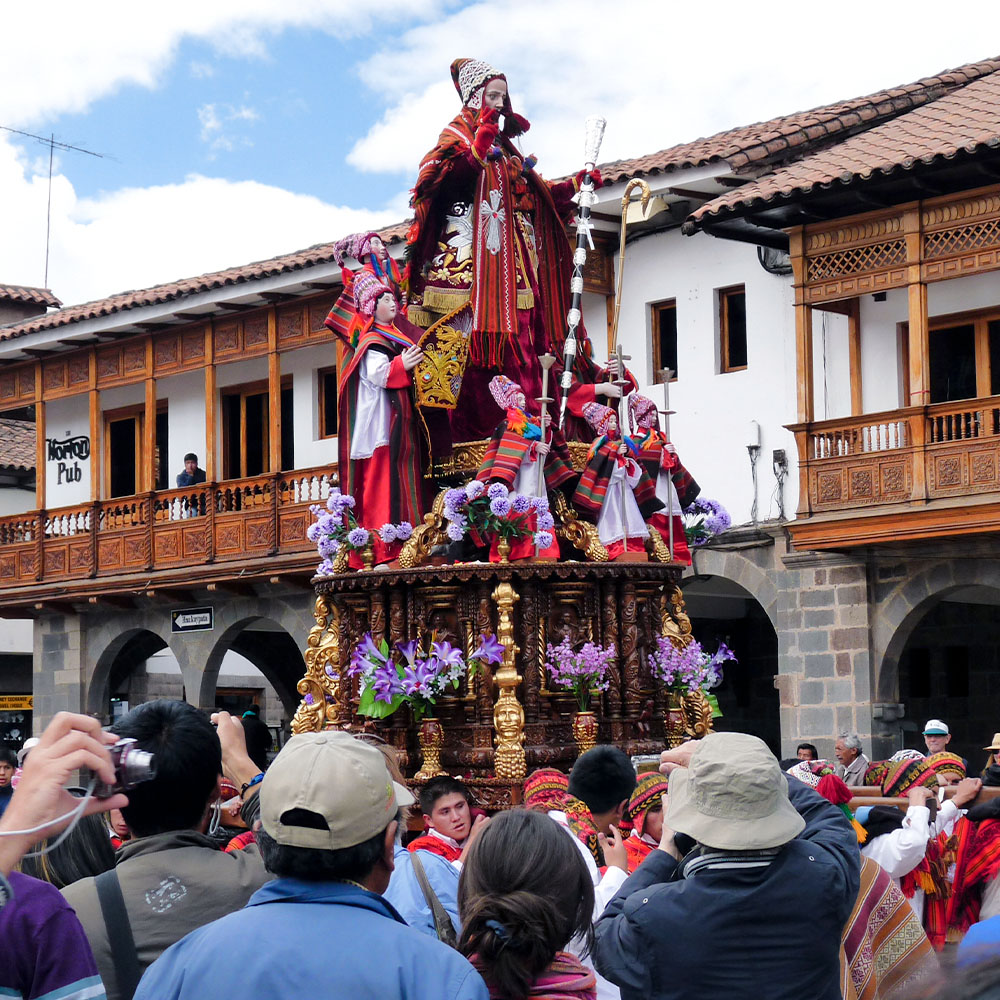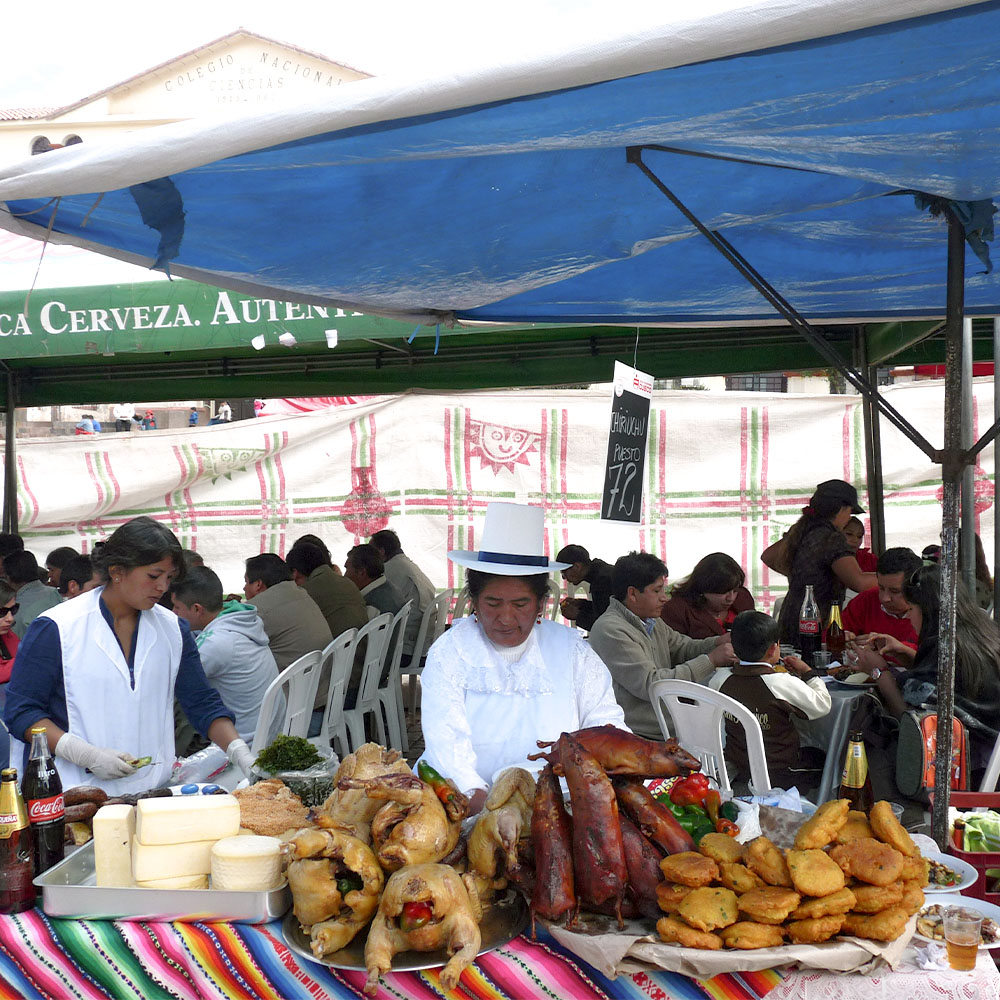

The origins of this grand celebration date back to the time of the Incas, when the mallquis (mummified bodies of the Incas) were honored. Annually, the people held processions through the city as part of a cult to honor the deceased. These processions concluded with massive gatherings where ceremonial banquets were served, featuring abundant food and the traditional aqha, now known as chicha blanca, as an act of reverence to their deities.
It wasn't until the arrival of the Spanish invaders that this tradition underwent a significant change due to the introduction of Catholicism and the religion they brought with them, as they considered these acts to be degrading to their culture and religion.
The religious authorities of that time decided to end this tradition, which they deemed “pagan,” forcing the replacement of the venerated remains with images of the Virgin Mary and some Catholic saints. Thus, in Cusco, this tradition began, which endures to this day and has become part of Andean culture.
There have been some events that impacted the celebration, such as the earthquake in the 1950s in Cusco. During that time, there were difficulties in carrying out the procession of the saints because the families affected by the earthquake were sheltered in the plaza. Despite the situation, the route was adjusted to allow the procession to proceed as usual.
Another significant event was the death of Archbishop Luis Vallejos in 1982. The ecclesiastical hierarchy ordered the suspension of that year's procession; however, the mayordomos rejected the proposal. The procession went ahead as usual but with some changes reflecting the mourning situation of that occasion.
In the city of Cusco, some activities are regulated by the lunar calendar, including Holy Week, the festival of the Lord of Qoyllurit’i, and the Corpus Christi procession.
In the case of Corpus Christi, it is observed nine weeks after Holy Thursday (Holy Week), generally between May and June; however, the date always falls on a Thursday. Thus, on Thursday, May 30, 2024, this festival will take place. Many Cusqueños and visitors eagerly anticipate this time to witness the procession, as it is undoubtedly a unique experience to behold.
The festivities begin on Wednesday, the day before the central procession, with each saint leaving their temple. Each saint is accompanied by a procession that includes the mayordomos or "carguyoq", in some cases the district mayor, a band of musicians or "q'aperos", and especially the faithful who voluntarily choose to accompany their saint.
All the images participating in this great procession gather in front of the Santa Clara church before proceeding to the cathedral in Cusco's main square; it is said that the images must arrive at a specific time, respecting the traditional order.
The statues of the saints are taken to the cathedral and remain there until the following day, which is the central day of the procession. According to popular beliefs, it is said that meetings are held among all the parish images during the nights they stay in the cathedral.
The central day of this festival is a busy one for the mayordomos, as they are responsible for ensuring that the event unfolds according to tradition and meets the expectations of the faithful of each religious image. A clear example is the attire of each image, which must be dressed in its most luxurious garments and most prominent jewelry each year for this festival, which involves thousands of people from different parts of Cusco.
The caretakers bring out their saint or virgin from the Basilica Cathedral and the procession begins. The Plaza Mayor fills with people, and the excitement of witnessing this procession is palpable. The order in which the saints appear is as follows:

The mayordomos, without making distinctions, distribute gifts to the attendees during the procession, handing out items such as postcards, souvenirs, etc. The procession ends at approximately five in the afternoon after all the saints return to the Cathedral, where they will remain until the following Thursday, when the faithful, the mayordomos, the mayor, and others return the saints to the temple from which they came.
The traditional dish of this festival is Chiriuchu, a cold and spicy dish exquisite for discerning palates. It is a mix of 10 ingredients, including roasted guinea pig, cau cau (fish roe), boiled chicken, jerky, qochayuyo (seaweed), sausage, white corn cancha, cheese, sliced rocoto, and the typical torreja. This torreja, with a spongy consistency, is a combination of ingredients such as corn, pumpkin, and a little chicken broth during preparation, giving it a characteristic flavor when served.
According to some accounts, its creation dates back to the time of the Incas, specifically from the Ayni, a system of reciprocal family work, where at the end of the daily work, the best from each house was shared, creating a mix of foods from different regions, resulting in a delicious banquet.
An interesting fact is that this dish represents the duality of the Inca world because it was offered to the Sun God, a warm being, and had to be eaten cold. Coincidentally, its name in Quechua reflects this: chiri = cold, and uchu = food, translating to "cold food."



Happy passengers